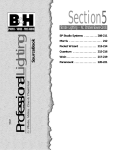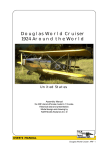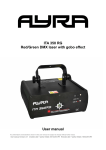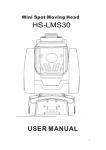Download Second Quarter 2009
Transcript
GRAFLEX HISTORIC QUARTERLY VOLUME 14 Since 1996 ISSUE 2 SECOND QUARTER 2009 FEATURES final years that he was seen, on occasion, with a pocketable 120 folding camera. John H. Boyd and his camera…. By Robert Lansdale…..…………….…1 The National Graflex Collectors’ Guide by Ken Metcalf………….…….4 GRAFACTS…. The Mark III Reflectorless Electronic Flash Unit, Predecessor of the Graflex Globe Strob 250 by Bill Inman…….………...6 Subscriber Graflex-made Photos…………………..…………………....8 In the early days, a competent photographer completed an assignment with only one exposure. A backup might be taken if the subject happened to close his eyes. Such coverage meant less expense, as well as small storage. John H. Boyd and his camera… City of Toronto Archives Globe & Mail Col’n. SC 266-60350. By Robert Lansdale John kept a ledger in which he entered the description and names for his photos - often only one line. Luckily, the Globe and Mail donated their collection of negatives to the City of Toronto Archives, thus preserving a vast collection of John Boyd’s photographs. An exhibition of selected images of the 1930s was mounted at the City of Toronto Archives Market Gallery in 1986. One of John Boyd’s fortified Speed Graphics has been preserved in the camera collection of Mr. Al Gilbert of Toronto. John Boyd passed away in 1971 at the age of 73. The Toronto-born Boyd inherited his love of photography from his father. The elder John Boyd was an accomplished and knowledgeable amateur photographer. His images and bylined writings are to be found in many of the photographic journals at the turn of the century (1900). In fact, he used to regularly correspond on photographic matters with his friend George Eastman, the founder of Eastman Kodak. Images by Boyd Sr. are preserved in both the Archives of Canada and the Archives of Ontario. W With such proximity to photography, young John took up the mantle, and after a brief apprenticeship with a commercial firm, he was soon touring Southern Ontario as a freelance photographer taking shots for agricultural journals. Before long he graduated to freelancing for the Toronto Globe and in 1922, joined the paper as its first staff photographer; he stayed with the paper until his retirement in 1964. In 1936 a merger formed the Globe and Mail. Starting in the days of flash powder in the 1920s, Boyd used bulky bellows cameras on a tripod or clumsy reflex graphics that were the trademark of the press photographer. He upgraded and set a landmark when he “miniaturized” his cameras, going from 5ʺx7ʺ down to 3¼ʺ x 4¼ʺ, a trademark that lasted for most of his career. His cameras were fortified with braces and bolts to withstand the rigors of the press game. It was only in his As the paper’s top staffer, Boyd covered many of the most tumultuous events in Canada’s history, and was recognized as a professional who would go to any lengths to get the shot. One of the many tales recalls Boyd traveling by car north to Lake Simcoe where a plane had crashed on the ice during World War II. He hired a farmer to horse-and-sleigh him through snow-clogged sideroads and out to the middle of the lake. He evaded the security guard who had sought shelter in a nearby farmhouse, and managed to make two exposures on separate holders before the guard caught up to him. Boyd slipped one of the holders to the farmer, and told him come hell or high John Boyd entering data of the day's negatives into a register of the assignments. Book still exists to offer important information on the archives negatives. hen looking back at the history of photojournalism in Canada, the name John H. Boyd is one that cannot be ignored. Boyd, perhaps more than anyone, helped to define the profession in its early days and contributed much to its development throughout a distinguished career that spanned over 40 years. water to keep it under the horse blanket and see that it got to the Globe and Mail by the first bus. Boyd let himself lose the argument after he made the guard phone his superiors in Ottawa, and gave up the holder with one exposure in it. The other shot appeared in the next day’s paper, and John sent an extra print to the Air Force guard in a friendly nosethumbing gesture that was always expected and received in such situations. On another plane crash, Boyd used moonlight to capture the scene. By the time the press boys got to the scene outside Toronto, they were told all the wreckage had been pulled into a hangar pending the arrival of civil aviation inspectors. It sounded a bit fishy, so Boyd followed footprints in the snow and found the wreck still lying in the field where it had crashed. While officials and newsmen argued, John put his camera on a tripod and took long exposures. Finally, officials relented that flash shots could be taken (danger of leaking gasoline). But the next day’s papers showed that the long moonlight exposure by Boyd was by far the best. Starting at such an early period of newspaper photography, Boyd was quite the innovator and pioneer in the use of new techniques. He was the first news photographer to use flashbulbs, the first to transmit a wirephoto and (it’s hard to believe) the first press photographer to write his own photo captions – something inherited from his father. Boyd told the story of photographing the first Annual Costume Ball of the Ontario College of Art. Photographers of the three Toronto dailies moved onto the dance floor to record the gay costumes and high jinks. After a shot apiece, the room was so full of flash powder smoke and the floor so grimy with ashes that the party was closed down to clear the air and mop up the mess. The following year photographers were restricted to a side room with a huge flash gun tripod in the center of the room with each photographer posing their own group in a different corner. On a given signal, the one flash was used by all photographers. There were always efforts to scoop the opposition. Before the merger of the two morning papers, if Boyd got a good picture or story which the Mail had missed, then the Globe would print 50 special copies of the first edition with the important photos missing. A Mail copy boy was always assigned to buy a Globe first edition as soon as it hit the streets. So photo-less papers were delivered to newsstands nearest the Mail & Empire offices. There was nothing in the dummy issues to alert the M&E editors, so they could not catch up on the story. The Mail looked pretty sheepish in the out-of-town and early local editions. Back in 1923, when an elaborate junction of five streetcar lines was nearing completion in west-end Toronto, film speed and flash weren’t what they are today, so ingenuity was necessary to overcome a challenging situation. The ceremony for driving the “last spike” was not to be missed by the newspapers, but a problem arose when the event was scheduled to happen at night. To John Boyd that meant a lot more flash powder was needed to illuminate the expansive scene. John coaxed the other press photographers to pool their quotas of powder while he built a super-sized reflector in which the powder would be fired. On the night of the event, all lensmen gathered on a high vantage point overlooking the scene and arranged their big view cameras mounted on tripods. Each photographer added his supply of powder to the big curved metal contraption that John had created as a flash-pan. At the arranged moment in the ceremonies, the dignitaries and workers posed rigidly for the official photograph. John gave the signal to remove lens caps and fired off the shot. KA-BOOOOM went the powder, and everything became brilliant daylight. What an explosion – the buildings shook – the ground trembled – the pan took off like a bird, spiraling through the air, and the surprised photographers ducked for cover. When the smoke and commotion had cleared, everyone realized they had 2 missed the shot completely, as every camera was shaken by the explosion that provided the light. There wasn’t enough powder left, nor nerve, for a second try. Boyd was covering a Ford strike in Windsor, Ontario, with negotiations dragging on with boredom. The negotiators were on the seventh floor of a rather old hotel with very slow elevators. All the press photographers were patiently waiting down a hall from the meeting room. John decided to pull one of his famous pranks. Out of sight of everyone, he called out just as he slammed the door of the elevator: “Just one more, Mr. Ford!” and flashed off a bulb. Alerted, the photographers all stampeded down the seven flights of stairs, hoping to beat the elevator and get a quick shot of Ford before he left the building. Needless to say, John waited and chuckled merrily. During scarcities of World War II, John was noted for getting the longest wear out of his automobile tires and the best gas mileage. After every hill he had to climb, he went into neutral and coasted down the other side. All photographers were instructed when on assignment outside the city to visit the local drug stores and pick up any available flashbulbs. As a result, the Globe and Mail had a ready supply with empty hypo barrels full of the most useful bulbs. All things don’t work to success, as John found out when carrying out the orders-from-on-high from none other than the paper’s publisher George McCullagh. A photo was to be taken during a testimonial dinner in Ottawa for the Allward Brothers who had designed and executed the Canadian War Memorial at Vimy Ridge. The photo had to be wirephotoed to Toronto for the first night’s edition so that the papers with photo would be in Ottawa the next morning. John worked on it for two days with Chateau Laurier Hotel officials, with the banquet organizers and with the principals themselves. Everything was totally in place by 4 PM… flowers, food, staff and subjects – just so Boyd could get his shot well in advance of the actual event. So he got the photograph completed and wirephotoed to Toronto, landing on the editor’s desk about 4:30 or so. Then John went off to enjoy the evening with his buddies. On returning to his room, his doorway was clogged with frantic messages like: WHERE THE HELL IS THAT ALLWARD BANQUET PIC? To give the dismal end, John phoned Toronto to find that his picture had been buried under a pile of copy… and never got unburied. Anything that arrived so early in the day could hardly be expected to be important. It would have been better to send it at 8 PM at the tingling moment of deadline time. Braced, bolted and painted with a black lacquer, the Boyd Speed Graphic has survived through the rigors of the press world. Boyd’s cameras were said to be strong enough to stand on. [Ed. This article was originally published in 2007 in the prestigious Photographic Canadiana, of which Bob Lansdale is the editor. All pictures on following page are by Bob. Membership and Society information can be obtained at http://www.phsc.ca. He is also a retired photojournalist and generous supporter of the Quarterly.] An arrest is made by three mounted police during a Communist led protest on February 25, 1931, the protest marches being the result of the Depression lay-offs. Firing button. Graflex cut film magazine, tubular finder (probably not Graflex), Leitz rangefinder, firing button, and homemade copper tubing handle. The battery case of hardened masonite measures 3 3/8ʺ x 3 1/2ʺ at its thickest point and stands 13ʺ tall, with a flash reflector added to the top to reach 18 1/2ʺ high. Extra outlets – a three-plug housewiring converter, provide the opportunity for extension flash. The five inch reflector for #5 bayonet bulbs, slides off a mounting bar to reveal a receptical for larger screw base bulbs. There must have been a larger reflector for those powerful bulbs. The smaller reflector must have been a “new” adaptation when the smaller #5 bulb became available and was quickly taken up by press photographers. There is even a patch of sandpaper glued to the side of the tower to polish the lead base of bulbs, which assured better electrical contact. The flash was reputed to carry at least a dozen D-cell batteries which would never fail even in winter. In its first construction I believe that was the case. But on opening the back of the unit, I was surprised to find it converted to a BC system. Four capacitators gave it the weight. A handwritten label reads: “November 25, 1952 – 20 Amps”. Batteries must be housed in the top which had less accessability to entry. Compur shutter, 135mm Xenar lens & hood, and heavy handmade 3 and front standard to rigid posisolenoid. Note the bolts securing braces tion. 3-plug outlet adapter for flash extensions. CAMERA COURTESY OF THE AL GILBERT COLLECTION Cameras, originally purchased without cable release sockets, can be equipped with cable release and sockets” (1938-39 Confidential Trade Price List). A Series II camera has been located from a 1934 batch that does not have either cable release. Probably rare.2 The picture above, from a 1933 advertisement, shows the Series I camera without cable release sockets. The National Graflex Collectorsʼ Guide If the seller cannot supply the serial number, the sliding cover for the ruby window is another good indication that the camera is a Series II. By Ken Metcalf I Here is a comparison of the models. n my opinion, the single lens reflex National Graflex is not a user camera, but rather an interesting camera for collectors. Because of the self-capping shutter and comparatively complicated shooting procedure, many no longer work, and few people are capable of repairing the camera. As an indication of the repair problems, Graflex prepared what may be the first service manual (c. 1934-1945), using tipped-in photographs and typewritten instructions. Also, possibly indicating operating problems, Graflex completely rewrote and expanded their 1934 instruction booklet in 1940, from 24 pages to 32 pages. This article is intended to help the collector find authentic and exceptional examples of this interesting camera. A model called the “Series I” (without the “I” on the hood or in catalogs until 1935, and called the “Single-Lens Model” when the Series II was introduced) was sold from 1933 through 1935 and a model called a “Series II” from 1934 through 1942. It has been suggested that it was discontinued at the start of World War II by the company, so they could concentrate on wartime production. Based on a 1944 Graflex Availability List, it is also possible that the government assigned a very low priority rating, thus effectively stopping sales. Several cameras and a 1947 instruction booklet have been located (See GHQ Volume 9, Number 3.) with post-war Graflex, Inc. markings on the hood and references to the 1947 Pacemaker Graphic, suggesting an attempt to revive sales or dispose of unsold cameras. 1 Also, the camera and accessories were listed in a 1945 Graflex, Inc. Pricing Supplement, and pictured in the catalog that had been used from 1941, with the Folmer Graflex name. There is a curious footnote to both the camera and some accessories that they were: “Unavailable from stock.” A special order? The camera was not listed in a 1946 price list. Accessories and parts were listed and available for some time after the camera was discontinued. Above: Door catch and straight lens struts for Series I on left. Series II on below. Top right: Series I, ruby window without cover. On this camera a Kalart rangefinder cover was added, possibly by Graflex. Right: Series I and later Series II with cable release sockets. Differences and similarities Series I Filter dimension 75mm lens 140mm lens Speed plate Telephoto “Horseshoe” clip First surface mirror Cable release provided I think the best way to identify the Series I is by serial number, which is stamped on the inside bottom of the removable back. Approximately 2,600 were produced, with the last serial number being 201,594. The series II was listed through 209,433, giving a production for this model of about 7,800. A complicating factor is that “Series I National Graflex Cameras could be rebuilt to conform to the Series II model. Series II 4 Series II 28.5mm in mount 30.5mm in mount 33mm unmounted No series is stated. Series II is stated. No Yes Yes Yes No Yes, 204,736 and later No Two (One possibly for use with a self- timer.)2 Mirror cocking lever Right side top Left side top Shutter winding knob Small outside ring Larger outside ring Release button for closing lens door Yes No Shutter release Slight differences between series. Microscope attachment inst. (Not mentioned in FG instructions, but mentioned in Graflex, Inc.) Ruby window No cover Sliding cover Opening at film plane 2¼ x 2½ 2¼ -1/8 x 2½ 3 Summary As primarily a Graflex camera collector, for this camera and others, my first consideration is which model I should look for. In some cameras, such as the 3A, it could be an early version, or a late version with the Autographic feature...or both. Often, the earlier version is of better quality, although with the National, they were so close in date, that is not an issue. The next consideration is condition. Because of the number of cameras available, the shutter should be working, there should be very little scratching of the leather or metal trim and the hood should have only minor scratches, particularly of the “Graflex” lettering. The only reason not to follow these criteria is a camera with very unusual features. I am still looking for an unusual Series II. As suggested by the filter comparison, the front diameters of the I and II lens barrels are not the same and are not interchangeable. Also, even though the lens on the I can be removed, the telephoto lens will not fit. It appears that one of the main conversion procedures was to change the arms that support the lens. If the reader has interesting cameras or accessories, or you do not agree with facts or opinions given, please let us know. ________________________________ 1 Jerry Spiegelʼs camera is covered in tan leather-grained plastic, and some metal surfaces are finished in black, not brushed aluminum. The hood is imprinted with the Graflex, Inc. name from 1945, which could have been used on replacement hoods, further confusing the identification of the camera. One reason for confusion in differentiating the models is that both have removable lenses and the chrome “horseshoe” clip. According to the instruction booklet for the Series I, the lens was removable “Since dust will accumulate on lens and focusing mirror, it is desirable to occasionally clean the surfaces thereof. To facilitate cleaning, remove the lens and mount after lifting the nickel finished horseshoe clip...” 2 It is interesting that Graflex sold both models at the same time (19341935), possibly to deplete the stock of the first model, although even in 1935 dollars, it is hard to see why a buyer would not pay the $10 difference to have the telephoto potential. Two cameras 180327R and A180283, which are in the Series I serial number range and were in the same batch scheduled in 1932, have Series II features and the unusual letter addition to the number. Only the 1935 catalog says that the National Series II is optionally available (at no extra charge) with fittings to accept a cable release, permitting the use of a self-timer as well as other delayed exposure devices. Comparing the 1934 and 1940 instruction booklets, neither cable release fitting is shown in the first, and both are shown in the later booklet. As noted later, in addition to the cable release sockets, several other features were different. There may be a few scarce Series II cameras with some, but not all, Series II features! The serial number range could be between 201,595 and 203,395. Accessories and advertising Telephoto lens Filters (Wratten) mounted - K-1, K-2, X-1, X-2, Sky, A, F, G, Aero 1 and 2. unmounted – K-1, K-2, Sky and Aero 1. Copying attachments – closest working distance of 12" and 18" Diffusion disk Self timer for delayed exposures and slow speeds from ½ sec. to 10 seconds. Cases Grain leather for camera and telephoto Suede Sportsmanʼs plush-lined Carry-all for camera and accessories Leather case for six filters Direct vision sight finder Tripods - No. 1 Crown or ebonized Crown Jr. including carrying unit Sunshade with case Microscope adapter Display cabinet and brochures 3 According to the cameras I have available, the opening is 2¼ x 2½ for the I, and 2-1/8 x 2½ for the II. According to the instruction booklets, the dimensions are the same for the I, and varies for the II between 2¼ and 2-1/8 for the vertical measurement. It is possible that the early II had an opening the same size as the I. If readers have cameras within the serial numbers in footnote 2, I would appreciate receiving a measurement of the vertical opening. Crown Jr. tripod Sunshade This company-made photograph shows the telephoto along with three lenses that were never listed for sale, but may be awaiting discovery. Direct vision sight finder 5 GRAFACTS …...... entire room. Use several to flood a room with soft natural light. Use it outdoors for synchro sunlight where too much flash must be avoided. Globe Strob is omni-directional lighting and unsurpassed for wide angle photography, since there is no ̒fall-off̕ effect.” The Mark III Reflectorless Electronic Flash Unit, Predecessor of the Graflex Globe Strob 250 Copyright William E. Inman, Sr. The Graflex 250 Strob features: A s the flashbulb began to lose its popularity, due to the advent of portable professional electronic flash units and the discontinuance of the Graflex Teleflash in 1963, a couple of enterprising Milwaukee Journal photographers came up with a rather new concept of electronic flash unit, which could be powered by a Stroboflash I, II, III, or IV Power Pack. As I recall, the photographers were Don Emmerich and John Murry. The unit was called the Mark III Reflectorless Electronic Flash, manufactured by RD Electronics in Milwaukee, Wisconsin, and, I believe, developed sometime after 1963. Globe 1. An offshoot of the Graflex 250 Strob, Graflex simply replaced the reflector head of the 250 Strob with the Globe Strob head, which was mounted on the handle that contained the Strob capacitor. The flashtube was enclosed and of a plug-in design. (It used a GE FT120 flash tube with a 10,000 flash life.) 2. The Globe Strob was powered by the same Power Pack as the Standard Strob 250. Everything was interchangeable. 3. The Globe Strob 250 could be used with both Graflex 350 Strob and three Strobomatic 500 Power Packs. (Special instructions were required.) 4. A special adapter cord was available for the Stroboflash Power Packs. Catalog No. 2260. 5. On the face of the Globe Strob is an Exposure Guide, an open flash button and an outlet for the Graflex Slave/Sync or the shutter trip cord. 6. A tripod socket was part of the handle base for swivel mounting on a light stand. The unit could also be mounted on a camera with a pair of Graflite Battery Case Clamps. Catalog No. 2771. 7. A non-Graflex made Lumi Quest Pocket Bouncer auxiliary pocket bounce reflector could be easily fitted to the Globe Strob by adding a strip of Velcro around the top of the Strob head. This gave a soft light and increased the f/stop by one. 8. An AC Adapter with a 20- foot cord was available as an alternate power supply in place of the battery packs. Recycle time was 4-5 seconds. It was not a battery charger. Catalog No. 2392. 9. The battery-operated Graflex Strobmeter was a valuable accessory when using the Globe Strob 250 or 500, to assist in determining a more accurate exposure using one or more units, and it read in direct F stops. It was made for Graflex by Wein. The Mark III features: 1. The lamphead was advertised as having “computer grade” components, which were considered superior to those of the Stroboflash lamphead. A new GE L.A.S.C.R. circuit provided contact isolation with low idling time battery drain. 2. A ready light 3. A built-in slave cell 4. A shutter sync. outlet 5. The plug-in flashtube could be replaced in the field. 6. It had a high impact housing with a cast Plexiglass flash tube lens cover. 7. It had a rugged aluminum base, with a tripod socket for a swivel for mounting on a Graflex Pick Feather Light Stand. 8. It was sold at professional net cost of $79.50. Each Milwaukee Journal photographer would carry three of these units on an assignment. They, of course, could use the regular Stroboflash lamphead whenever necessary, as well as everything was interchangeable with the SR Power Packs. In a sense, they were replacing their three SR Teleflash units with the Mark III units. Also, see GHQ, Volume 13, Issue 4 and Volume 14, Issue 1. I do not know if the unit was patented. After the Graflex Strob 250 was introduced in 1970, Graflex introduced the Globe Strob 250 in 1971. Similar in appearance to the Mark III Reflectorless Electronic Flash unit, the Graflex 250 Globe Strob was, to be sure, a reflectorless electronic flash unit, but with different features. According to Graflex, the Globe Strob “is a bare tube electronic flash built to let you do more at lower cost with soft, soft light. Use it for effects from natural light to hot flash, for fill-in lighting in a variety of circumstances. Placed high in a corner or along a wall, it will provide fill light throughout an 6 The 250 Globe Strob was a very versatile unit. Strob Adapter Cords and Slave/Sync A companion, the Globe Strob 500, was introduced at the same time, 1971. It was designed for the Graflex Strobomatic 500 but could be mated with the Graflex Strob 350. It could also be used with all the Stroboflash Power Packs, using the same adapter cord as the 250. Graflex Globe 500 features: Strob 1. The Globe Strob 500 did not have an open flash button but accepted the slave/sync in the shutter cord outlet. 2. It was supplied with a heavy duty swivel clamp using the tripod socket in the base. 3. A hollow metal Tube Handle, Catalog No. 2245, could be fitted to the Globe Strob 500 for hand-holding or mounting on a camera with Graflite Battery Case Clamps. Catalog No. 2771. 4. Both the Glob Strob 250 and 500 accepted the Globe Strob Plug-in Reflector. Catalog No. 2246. It had the same characteristics as the Strob 250 lamphead. I did not find this accessory to be very useful, as it was meant to be pointed upward to light up an area, not as a primary light source. The Globe Strob was very useful when photographing home and office interiors of all kinds. Usually three to four units would be set up as slave units and tripped by the flash unit on the camera. References: Singer/Graflex 1971 price list Singer/Graflex 1971 brochure Singer/Graflex 1973 8-page brochure RD Electronics Mark III brochure Singer/Graflex Globe Strob 250, 350 RG and 500 service manuals Personal collection and use 1970 Singer Graflex four-page brochure. Find the Globe Strob! Globe Strob 500, Stob 350RG, and Strobmeter. 7 Graflex Historic Quarterly The Quarterly is dedicated to enriching the study of the Graflex company, its history, and products. It is published by and for hobbyists/users, and is not a for-profit publication. Other photographic groups may reprint uncopyrighted material provided credit is given GHQ and the author. We would appreciate a copy of the reprint. Editors: Ken Metcalf and Les Newcomer PHOTOHISTORY XIV October 16-18, 2009 One-year subscription: mail US$14 email Free [Payable to Ken Metcalf] Editor Les Newcomer is a featured speaker. Contact: The 14th Triennial Symposium will be held in Rochester at the George Eastman House, International Museum of Photography. With world-wide attendance, it is held ONCE every three years so should not be missed. Friday: Registration; Saturday: Symposium lectures; Saturday evening: Banquet; Sunday: Trade Show. Reserve rooms at Double Tree Hotel, Rochester, N.Y. www.doubletree.com Full brochure available at www.tphs.org Ken Metcalf 94 White Thorn Dr. Alexander, NC 28701-9792 E-mail: [email protected] Les Newcomer 33922 Grand River Avenue Farmington, MI 48335-3432 E-mail: [email protected] SUBSCRIBER GRAFLEX-MADE PHOTOS Fred Haeseker, Girl in T-shirt. 1931 RB Graflex Series B. Dick Loepp, 1943. 2 1/4 x 3 1/4 Series B. Fred Haeseker, Bay arcade. Calgary, Canada 1947 Crown Graphic 23 8 Bill Baker self portrait, Diet Building, Tokyo, 1947-1949.

























